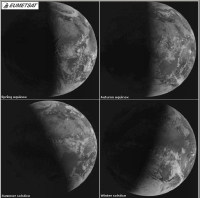|
|
June 21, 2006
Longest day of the yearSummer solstice is the day of the year with the longest period of daylight and the shortest night, and marks the first day of the season of summer.
During the year, the position of the
Sun as seen from the Earth moves north or south depending on the
season. When the Sun changes direction, it seems to stand momentarily
still.
Summer solstice usually occurs on 21/22 June in the northern hemisphere and on 21/22 December in the southern hemisphere. As a curiosity, the Arctic Circle is the imaginary line that marks the latitude above which the sun does not set on the day of the summer solstice and does not rise on the the day of the winter solstice. North of this latitude, periods of continuous daylight or night last up to six months at the North Pole.
The top image shows the distribution of
night and day on Earth as seen from Meteosat-8 21 June 2005 at 06:00
UTC. The two top figures are spring and autumn equinoxes (meaning the
moment when the Sun passes over the Equator), and below are the two
solstices with northern hemisphere summer on the lefthand image,
and northern hemisphere winter on the righthand image.
|
|
||||
